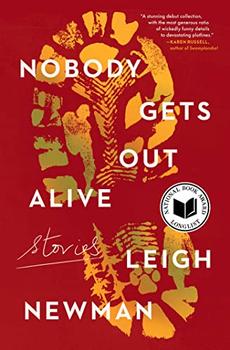Summary | Excerpt | Reading Guide | Reviews | Beyond the Book | Read-Alikes | Genres & Themes | Author Bio

Stories
by Leigh NewmanThis article relates to Nobody Gets Out Alive
 Small airplanes are a common form of transport in Leigh Newman's collection of short stories, Nobody Gets Out Alive, set primarily in Alaska. Several of the stories take place on a lake where homes boast "seaplane docks." Alaska is a vast, sparsely populated region where it's estimated that around 80% of communities exist beyond the reach of roads, making air travel essential.
Small airplanes are a common form of transport in Leigh Newman's collection of short stories, Nobody Gets Out Alive, set primarily in Alaska. Several of the stories take place on a lake where homes boast "seaplane docks." Alaska is a vast, sparsely populated region where it's estimated that around 80% of communities exist beyond the reach of roads, making air travel essential.
Bush planes, also known as STOL (Short Takeoff and Landing) aircraft, can land on short runways. With rugged "tundra tires," they're able to land in a clearing or meadow without pavement. Planes can also be outfitted with skis to land on snow or ice, and seaplanes are designed to land on water. Such conveniences matter in a region with active glaciers, a long snow season and more than three million lakes.
In Alaska, there are about six times more licensed pilots per capita than in any other state. Planes deliver building supplies, food and heating fuel to remote communities. Remote healthcare by plane is common; and small planes are also used to transport mail, teachers and even students. Access to recreational and commercial fishing grounds often depends on air transport. Mountain climbers, search-and-rescue crews and others venturing into the wilderness are likely to rely on bush planes. Tourists are also invited to take to the skies for scenic glacier flights, wildlife viewing or travel to isolated fishing and hunting camps. Small aircraft transport is not without risk. Capricious winds and other unpredictable weather patterns can interrupt flight plans, causing delays in delivery of essential supplies or medical care.
Lake Hood, the busiest seaplane base in the world, is located near Alaska's most populous city, Anchorage. Anchorage is home to the Alaska Aviation Museum, which displays a collection of vintage aircraft reflective of the important history of planes in the state.
One example of a favorite plane in the region is the De Havilland DHC "Beaver," which is a floatplane, a type of seaplane outfitted with buoyant "floats" for water landings. Floatplanes can be configured to deliver building materials, household appliances or even small boats to sites beyond the reach of roads. The Piper Super Cub plane can navigate very short landing zones with its "taildragger" wheel design; Pipers can have standard tires swapped out for tundra tires, and are sometimes modified with floats or skis when needed. Cessna planes, another popular type of aircraft, can be configured with tires, floats or skis as desired. All of these rugged bush planes have proven themselves — historically and in the present day — to be an essential part of daily life in most parts of Alaska.
Piper Super Cub DL3157 in Juneau, Alaska. Photo by gillfoto (CC BY-SA 2.0)
Filed under Places, Cultures & Identities
![]() This "beyond the book article" relates to Nobody Gets Out Alive. It originally ran in May 2022 and has been updated for the
April 2023 paperback edition.
Go to magazine.
This "beyond the book article" relates to Nobody Gets Out Alive. It originally ran in May 2022 and has been updated for the
April 2023 paperback edition.
Go to magazine.
Experience is not what happens to you; it's what you do with what happens to you
Click Here to find out who said this, as well as discovering other famous literary quotes!
Your guide toexceptional books
BookBrowse seeks out and recommends the best in contemporary fiction and nonfiction—books that not only engage and entertain but also deepen our understanding of ourselves and the world around us.